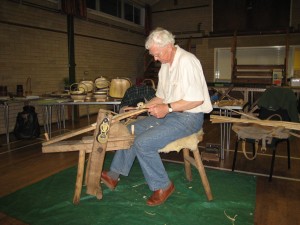
My trugs are completely hand made as they were originally many years ago and I have been making, teaching and demonstrating this process for over 20 years.
I cleave the panels out of white willow. The chestnut is done the same way and is used for the handles and frames. These are all shaped with a draw knife on a workhorse. This whole process I demonstrate at shows and exhibitions. The chestnut has to be steamed and formed into handles and frames of varying sizes. The seasoning period for chestnut is about six months so I prefer to do the cleaving whilst the wood is still green. The willow panels are soaked in water so I can shape them to fit the frames as the trugs are assembled. My demonstrations cover all this from starting with the timber in the round to the finished trug, apart from the steaming of the chestnut.
The history of the trug goes back hundreds of years. I have had hours of discussions about this with other craftsmen, also many older woodmen with whom I have worked. Unfortunately many of these characters have passed on. My own thoughts on the history of the trug are based on all the talks we have had.
I am sure it would have started in the charcoal industry when charcoal was used in the smelting of iron. The trugs would be used to earth up the clamps of charcoal and a round handle-less basket – a swill or spalk basket – would have been used. I have made a round trug in the same way with handles on the sides and not as we see the trug today which has a handle over the top.
Once the charcoal was prepared, the baskets were then used to feed the smelting furnaces. Baskets of this type could have been produced on site as they would have been manufactured from green wood, this being done while the charcoal was forming.
Coppice chestnut was used for charcoal and the charcoal used to smelt iron. The smelting process required an abundance of water and where there is water, there is also bound to be willow. So the ingredients were all to hand for making these baskets.
Throughout Sussex there are still many old sites of iron works and in fact I have had some willow myself from an old hammer pond. Progressing from there, a handle would have been added as further uses were found for the trug on smallholdings and farms for stock feeding and vegetable collection.
The move of the trug to garden work was due to Queen Victoria ordering some at the Great Exhibition of 1851 in Hyde Park from Thomas Smith of Herstmonceaux. On completion of the order, Thomas Smith took the trugs to London in a hand cart.
John Carnell
Traditional Trug Maker
1066 Country Trugs
Our popular garden trug baskets are completely hand made as they were originally many years ago. The panels in the trugs are made from white willow; sweet chestnut is used for the handles and frames.
Enquiries: telephone Hastings (01424) 440537